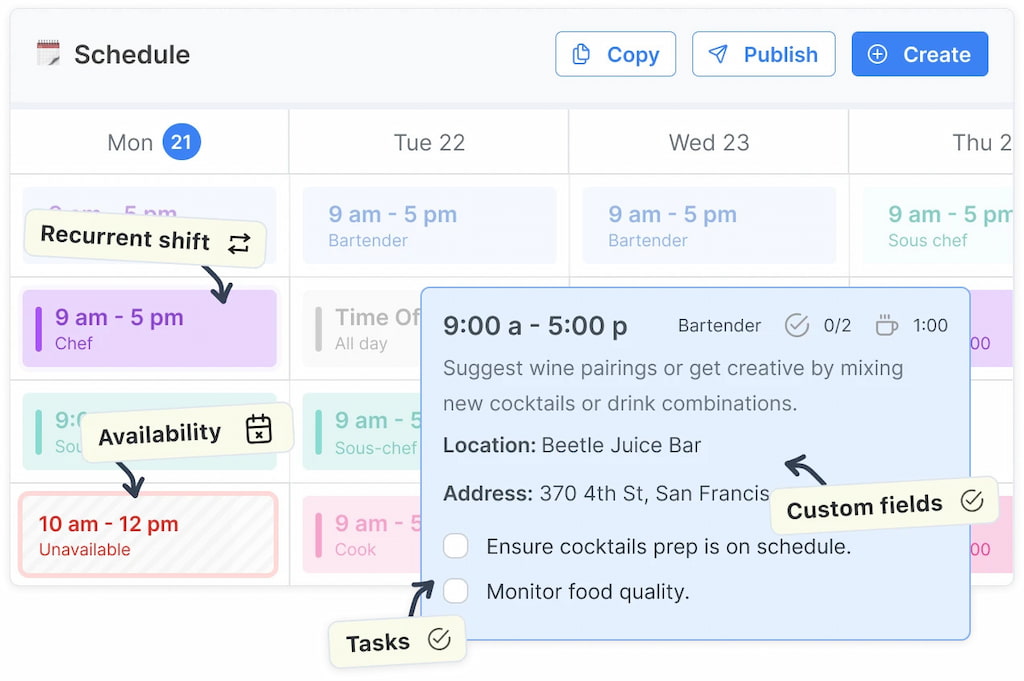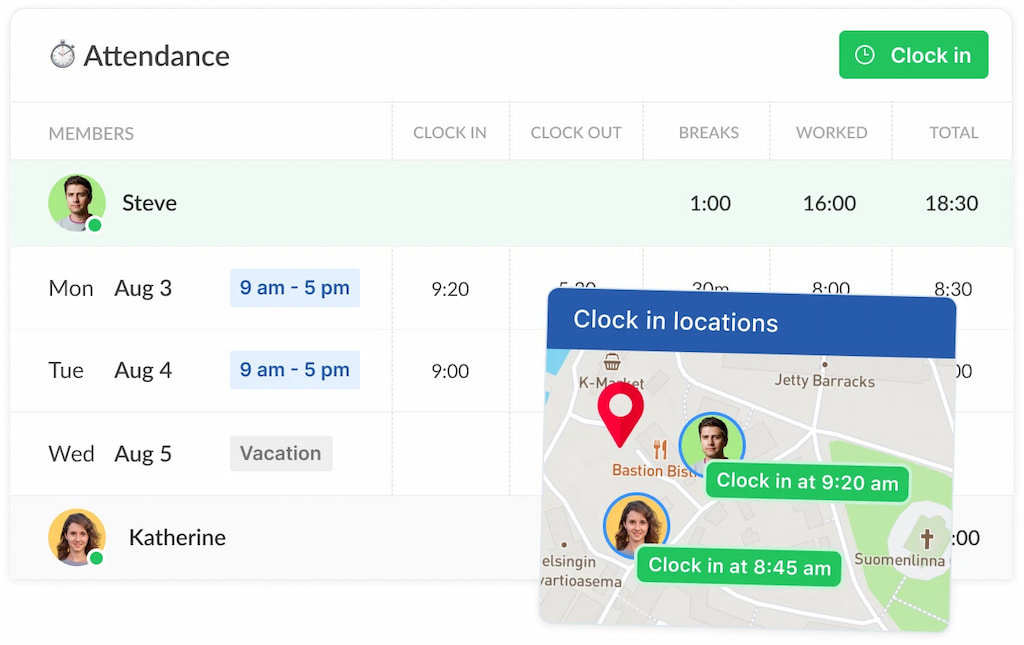Managing staff schedules in healthcare is a high-stakes challenge. From hospitals to clinics, missed shifts or coverage gaps can directly affect patient care and staff well-being. That’s why healthcare scheduling software systems have become essential. Tools like Shifts by Everhour streamline shift planning, track hours in real time, and simplify communication, helping medical teams stay organized and compliant. In this article, we’ll explore how the right software can optimize staffing, improve efficiency, and reduce administrative headaches for healthcare organizations.
🏥 What is Healthcare Scheduling Software?
Healthcare scheduling software is a tool that simplifies and automates staff shift management in hospitals, clinics, and care facilities. It ensures the right healthcare professionals are scheduled at the right time, reducing errors and improving patient care.
Why it’s better than spreadsheets or calendars
- No double-bookings: Updates happen in real time.
- Centralized schedules: See who’s on duty, available, or where coverage gaps exist.
- No manual chaos: Say goodbye to email threads, paper schedules, and constant edits.
Core functionalities
- 🗓️ Shift planning: Assign regular, rotating, or on-call shifts efficiently.
- 🔔 Notifications: Alert staff instantly about schedule changes, swaps, or emergencies.
- ⏱️ Time tracking: Monitor attendance, hours worked, and overtime.
- ⚖️ Compliance monitoring: Ensure adherence to labor laws, certifications, and internal policies.
With hospital shift scheduling software, administrators can focus on patient care while keeping operations smooth and staff happy.
🩺 Key Features of the Best Healthcare Scheduling Software Systems
When choosing a healthcare scheduling system, these features can make a big difference for efficiency, compliance, and staff satisfaction:
- 🗓️ Custom shift patterns and recurring templates: Easily create and reuse schedules for regular, rotating, or on-call shifts.
- 🔔 Real-time notifications and alerts: Keep staff updated instantly about shift changes, swaps, or emergencies.
- 🎓 Credential and certification tracking: Ensure only qualified staff are assigned to specialized roles.
- ⏱️ Time tracking & payroll/HR integration: Monitor attendance, hours worked, and sync data directly with payroll or HR systems.
- 📊 Reporting and analytics: Track staffing levels, overtime, and labor costs to make informed decisions.
- 📱 Mobile accessibility: Let staff view shifts, confirm availability, and receive alerts from their phones.
These features help healthcare administrators reduce errors, improve coverage, and save time, ensuring smoother operations across departments.
🚀 Healthcare Scheduling Software Systems Breakdown
| Software | Key Features | Pricing | Ideal For |
|---|---|---|---|
| Shifts by Everhour | Shift planning, mobile access, notifications, time tracking | Free tier + paid plans | Clinics & small hospitals seeking unified scheduling & time tracking |
| QGenda | Rule‑based provider scheduling, credential tracking, mobile app | Quote‑based | Large hospitals & health systems with complex provider scheduling |
| OnShift | Templates, predictive scheduling, open‑shift fill, mobile app | Quote‑based | Senior care, long‑term care & multi‑unit health facilities |
| ScheduleAnywhere | Multi‑site coverage, real‑time staffing visibility, swap requests | Quote‑based | Clinics & multi‑location healthcare providers |
| Acuity Scheduling | Booking, reminders, calendar sync, payments | Free plan + paid plans | Outpatient clinics, telehealth, small practices |
| NextGen Healthcare | Scheduling + EHR integration, enterprise grade | Quote‑based | Large multi‑specialty clinics & health systems |
| CareCloud | Scheduling, practice management, analytics | Quote‑based | Medium size clinics looking for all‑in‑one solution |
| HealthStream | Staff scheduling, compliance tracking, mobile access | Quote‑based | Hospitals & health systems focused on workforce compliance |
| ShiftWizard | Custom scheduling rules, fatigue management, analytics | Quote‑based | Hospitals large or small needing deep scheduling logic |
| Agendrix | Scheduling, staff availability, time clock, communications | Free trial available | Smaller clinics or healthcare teams needing flexible scheduling |
🔧 Tool highlights
- Shifts by Everhour: Streamlined scheduling and time‐tracking platform ideal for clinics and smaller hospitals.
- QGenda: Advanced provider scheduling with credential tracking and mobile access.
- OnShift: Predictive scheduling and open‐shift management for senior care and long‐term settings.
- ScheduleAnywhere: Real‑time staffing visibility and multi‑site coordination for healthcare operations.
- Acuity Scheduling: Customizable booking and reminder solution, especially good for outpatient and telehealth practices.
- NextGen Healthcare: Enterprise scheduling integrated with EHR and practice management for large systems.
- CareCloud: Combines scheduling, practice management, and analytics for mid‑sized clinics.
- HealthStream: Focused on compliance, credential tracking, and mobile scheduling for hospitals.
- ShiftWizard: Deep scheduling logic with fatigue management and analytics support for complex healthcare workflows.
- Agendrix: Flexible scheduling, availability tracking, time clock and communication tools — ideal for smaller healthcare teams.
💡 How Shifts by Everhour Helps Healthcare Organizations
Managing healthcare staff schedules can be complex, but Shifts by Everhour makes it simpler, faster, and more transparent. Here’s how it supports hospitals, clinics, and care facilities:
- 🖱️ Streamlining shift creation and management: Build, copy, and adjust shift schedules in seconds using templates and drag‑and‑drop tools.

- ⚡ Real-time notifications and updates: Instantly alert staff of schedule changes, shift swaps, or emergencies to prevent miscommunication.
- ⏱️ Tracking attendance and hours worked: Monitor clock-ins, breaks, and total hours in one place for accurate reporting.

- 🔍 Improving transparency and accountability: Staff can view their shifts, request changes, and confirm attendance, keeping everyone on the same page.
- 📉 Reducing administrative workload: Automated scheduling, notifications, and reporting save time, letting managers focus on patient care instead of spreadsheets.
Shifts by Everhour turns healthcare scheduling from a stressful task into a smooth, reliable process, ensuring proper coverage while keeping staff satisfied and compliant.
❓ FAQ: Healthcare Scheduling Software Systems
What is healthcare scheduling software?
Healthcare scheduling software is a tool that automates staff shift management, tracks hours, and ensures compliance in hospitals, clinics, and care facilities.
Why should healthcare organizations use scheduling software?
It reduces errors, saves time, improves staff coverage, enhances transparency, and helps comply with labor laws and certification requirements.
How does Shifts by Everhour help healthcare scheduling?
Shifts by Everhour simplifies shift creation, sends real-time notifications, tracks attendance, and reduces administrative workload for healthcare teams.
Can scheduling software handle last-minute changes?
Yes, most modern healthcare scheduling systems, including Shifts by Everhour, allow real-time updates for shift swaps, emergencies, and staffing adjustments.
Is mobile access important for healthcare scheduling?
Absolutely. Mobile access ensures staff can check shifts, confirm availability, receive alerts, and communicate instantly from anywhere.
Do these systems integrate with payroll or HR tools?
Many systems, including Shifts by Everhour, integrate with payroll and HR platforms to streamline hours tracking, invoicing, and compliance reporting.
How does scheduling software improve staff satisfaction?
By allowing flexibility, visibility into shifts, and fair distribution of work, scheduling software reduces burnout and improves overall staff engagement.
Can small clinics benefit from healthcare scheduling software?
Yes, even small clinics gain efficiency, reduce manual errors, and save time managing rotations and coverage with tools like Shifts by Everhour.
🧠 Conclusion
Effective healthcare scheduling goes beyond filling shifts—it ensures coverage, compliance, and happy staff. Modern healthcare scheduling software systems automate planning, track hours, and reduce admin work.
Shifts by Everhour helps healthcare teams stay organized with real-time notifications, clear schedules, and better transparency. With the right tools, administrators can spend less time managing shifts and more time focusing on patient care.
While many healthcare and dental scheduling software systems provide value, Shifts by Everhour stands out. Its versatile scheduling features and streamlined workforce management tools make it the optimal choice for healthcare. By optimizing staffing levels and boosting efficiency, it sets the standard for modern workforce management.
Discover more about pharmacy scheduling software!
Optimize your hospital management today for smoother operations and better patient care.

